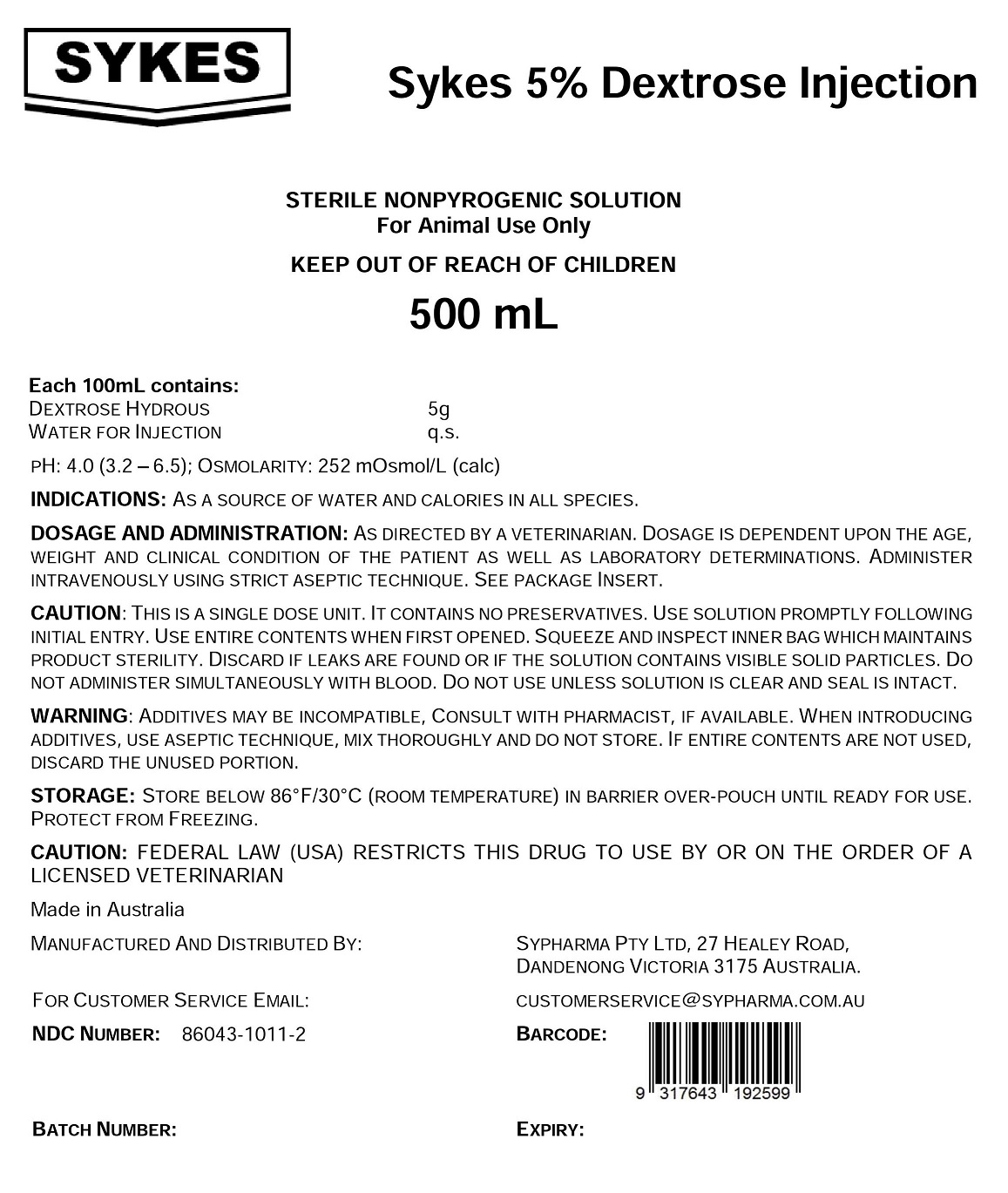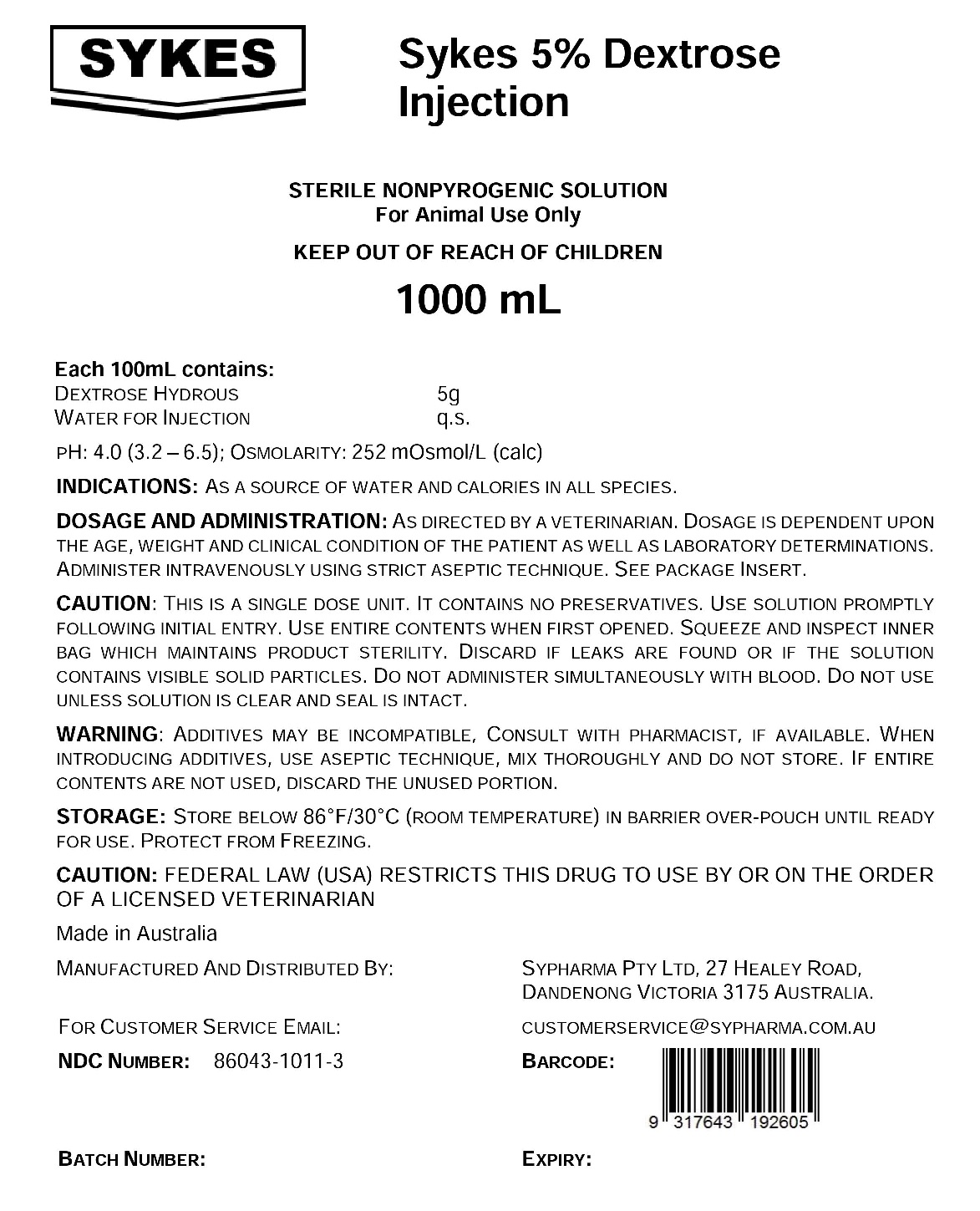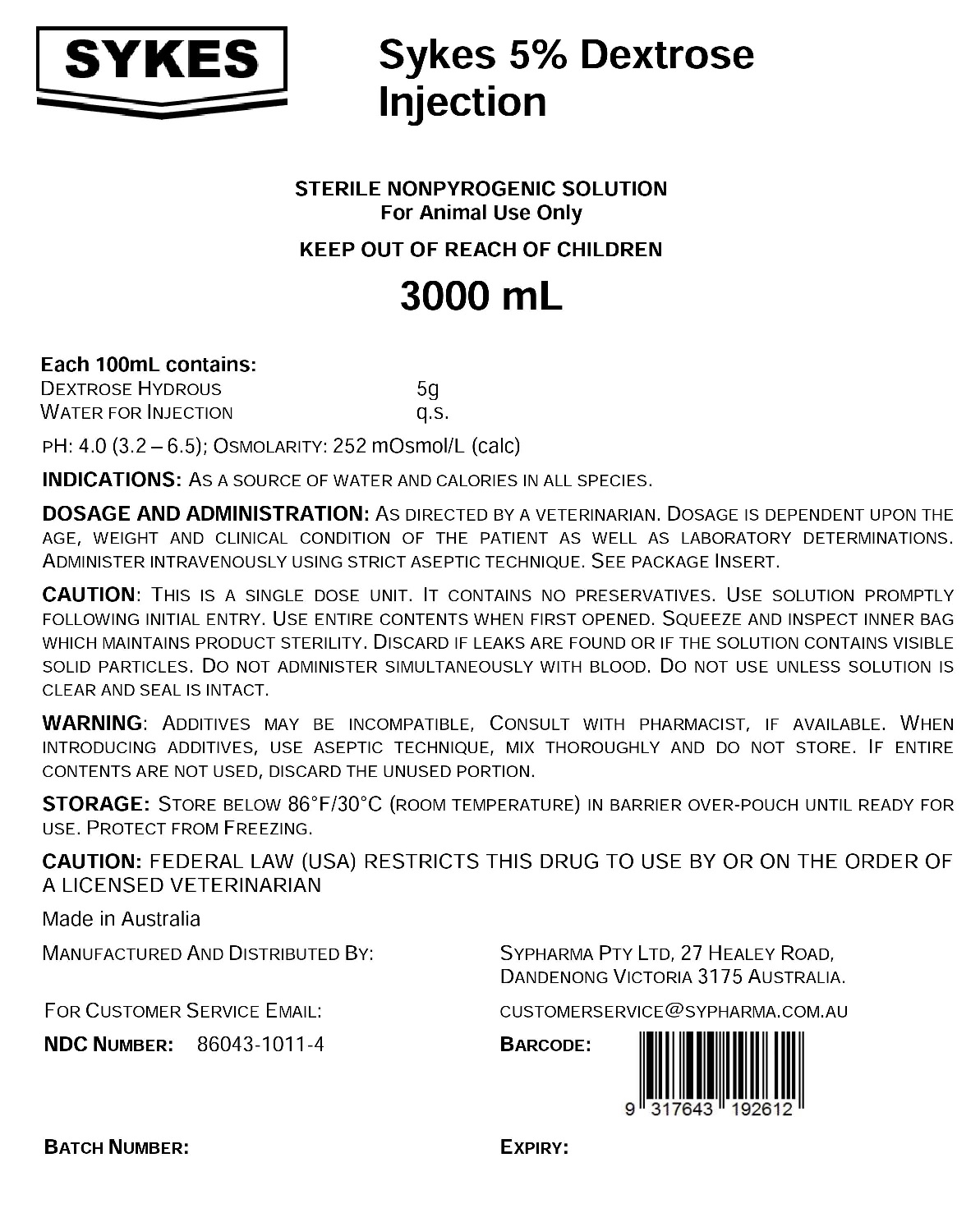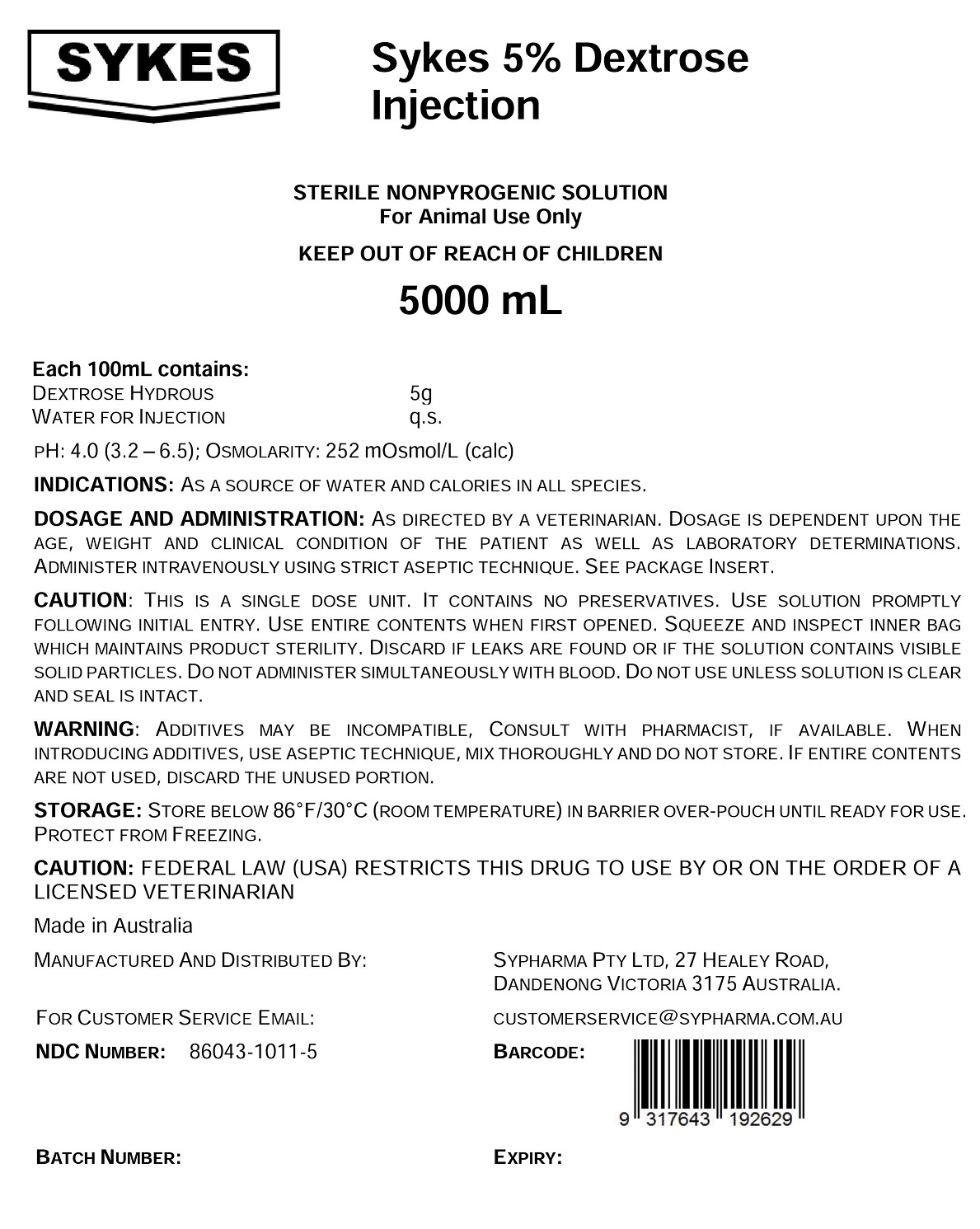Animal NDC 86043-1011-2 Sykes 5% Dextrose
Dextrose Monohydrate
Animal Product Information
Sykes 5% Dextrose Animal Product Labeling Information
The product labeling information includes all published material associated to a drug. Product labeling documents include information like generic names, active ingredients, ingredient strength dosage, routes of administration, appearance, usage, warnings, inactive ingredients, etc.
Table of Contents
- Description
- Clinical Pharmacology
- Indications
- Contraindications
- Warnings
- Adverse Reactions
- Precautions
- Dosage And Administration
- Over-Dosage
- Packs Supplied
- Directions For Use Of Plastic Container
- Sykes 5% Dextrose Injection 250Ml
- Sykes 5% Dextrose Injection 500Ml
- Sykes 5% Dextrose Injection 1000Ml
- Sykes 5% Dextrose Injection 3000Ml
- Sykes 5% Dextrose Injection 5000Ml
Description
Sykes 5% Dextrose Injection is a sterile, non-pyrogenic solution intended for fluid replenishment and caloric supply in single dose containers. May be administered intravenously using aseptic technique. It contains no antimicrobial agents. Discard any unused portion. Composition, osmolarity, pH and caloric content are shown in Table 1.
Table 1
The container is free of PVC and phthalates. The container meets the requirements of USP and is registered with US FDA.
Clinical Pharmacology
Sykes 5% Dextrose Injection has value as a source of water and calories. It will induce diuresis depending on the clinical condition of the patient.
Indications
Sykes 5% Dextrose Injection is indicated as a source of water and calories for all species.
Contraindications
Sykes 5% Dextrose Injection is contraindicated in patients with a known allergy to corn or corn products.
Warnings
Excessive administration of dextrose injection may result in significant hypokalemia.
Sykes 5% Dextrose Injection should not be administered simultaneously with blood through the same infusion set because of the possibility that pseudoagglutination of red cells may occur.
The intravenous administration of Sykes 5% Dextrose Injection can cause fluid and/or solute overloading resulting in dilution of serum electrolyte concentrations, overhydration, congested states, or pulmonary edema.
The risk of dilutive states is inversely proportional to the electrolyte concentrations of the injections. The risk of solute overload causing congested states with peripheral and pulmonary edema is directly proportional to the electrolyte concentrations of the injections.
Adverse Reactions
Reactions which may occur because of the injection or the technique of administration include febrile response, infection at the site of injection, venous thrombosis or phlebitis extending from the site of injection, extravasation and hypervolemia.
If an adverse reaction does occur, discontinue the infusion, evaluate the patient, institute appropriate therapeutic countermeasures and save the remainder of the fluid for examination if deemed necessary.
Precautions
This is a single dose unit. It contains no preservatives. Use entire contents when first opened.
Clinical evaluation and periodic laboratory determinations are necessary to monitor changes in fluid balance, electrolyte concentrations, and acid base balance during prolonged parenteral therapy or whenever the condition of the patient warrants such evaluation.
Sykes 5% Dextrose Injection should be used with caution in patients with known subclinical or overt diabetes mellitus.
Do not administer unless solution is clear and both seal and container are intact.
Dosage And Administration
To be used as directed by a licensed veterinarian. The dosage of the Sykes 5% Dextrose Injection is dependent upon the age, weight and clinical conditions of the patient as well as laboratory determinations. Parenteral drug products should be inspected visually for particulate matter and discoloration prior to administration.
For use in one patient on one occasion only. Discard any unused portion. Care should be taken with administration technique to avoid administration site reactions and infection.
Additives may be incompatible. Complete information is not available. Those additives known to be incompatible should not be used. Consult with Pharmacist, if available. If, in the informed judgement of the veterinarian, it is deemed advisable to introduce additives, use aseptic technique. Mix thoroughly when additives have been introduced. Do not store solutions containing additives.
Over-Dosage
In an event of over-hydration or solute overload, re-evaluate the patient and institute appropriate corrective measures. See Warnings, Precautions and Adverse Events.
Packs Supplied
Sykes 5% Dextrose Injection is available in containers in various sizes as follows:
Exposure of pharmaceutical products to heat should be minimized. Avoid excessive heat. It is recommended the product be stored at room temperature (86°F/30°C). Protect from freezing.
Directions For Use Of Plastic Container
To Open
Tear overwrap at slit and remove solution container. Some opacity of the plastic due to moisture absorption during the sterilization process may be observed. This is normal and does not affect the solution quality or safety. The opacity will diminish gradually. Check for minute leaks by squeezing solution container firmly. If leaks are found, discard solution as sterility may be impaired. If supplemental medication is desired, follow directions below:
Preparation for Administration
1. Suspend container from eyelet support.
2. Remove plastic protector from inlet/outlet port at bottom of container.
3. Attach administration set.
To Add Medication
WARNING: Additives may be incompatible.
To add medication before solution administration
1. Prepare medication site.
2. Using syringe with 0.63mm to 0.80mm needle, puncture medication port and inject.
3. Mix solution and medication thoroughly. For high density medication such as potassium chloride, squeeze ports while ports are upright and mix thoroughly.
To add medication during solution administration
1. Close the clamp on the administration set.
2. Prepare medication site.
3. Using syringe with 0.63mm to 0.80mm needle, puncture medication port and inject.
4. Remove container from IV pole and/or turn to an upright position.
5. Evacuate both ports by squeezing them while container is in the upright position.
6. Mix solution and medication thoroughly.
7. Return container to in use position and continue administration.
* The information on this page is for an ANIMAL PRODUCT, please review the complete disclaimer below.






